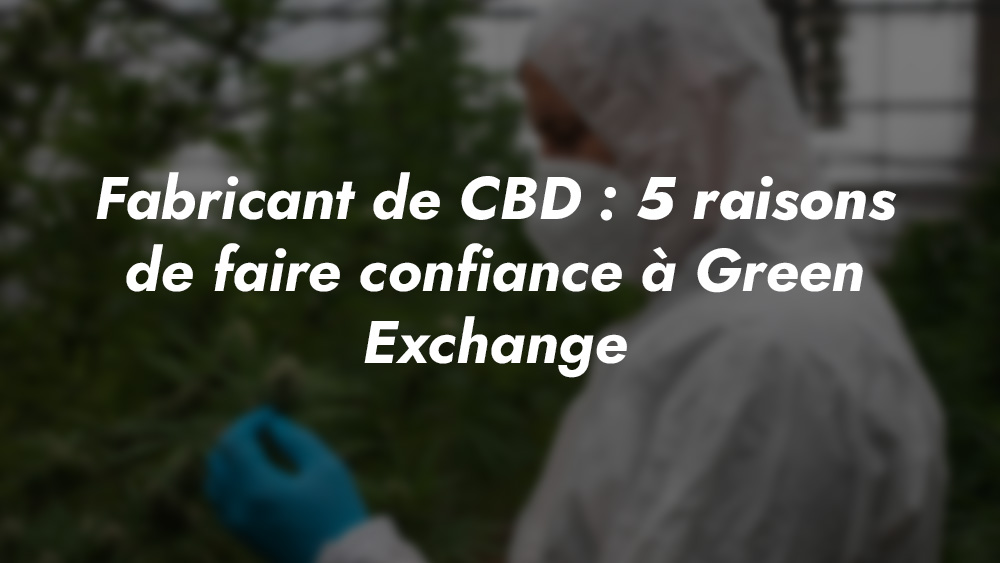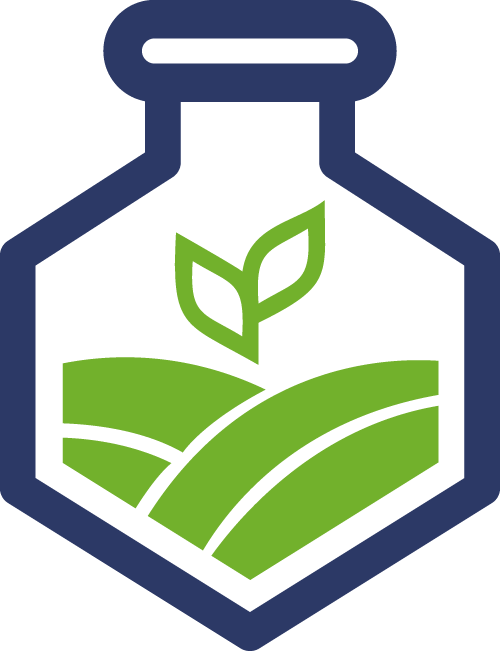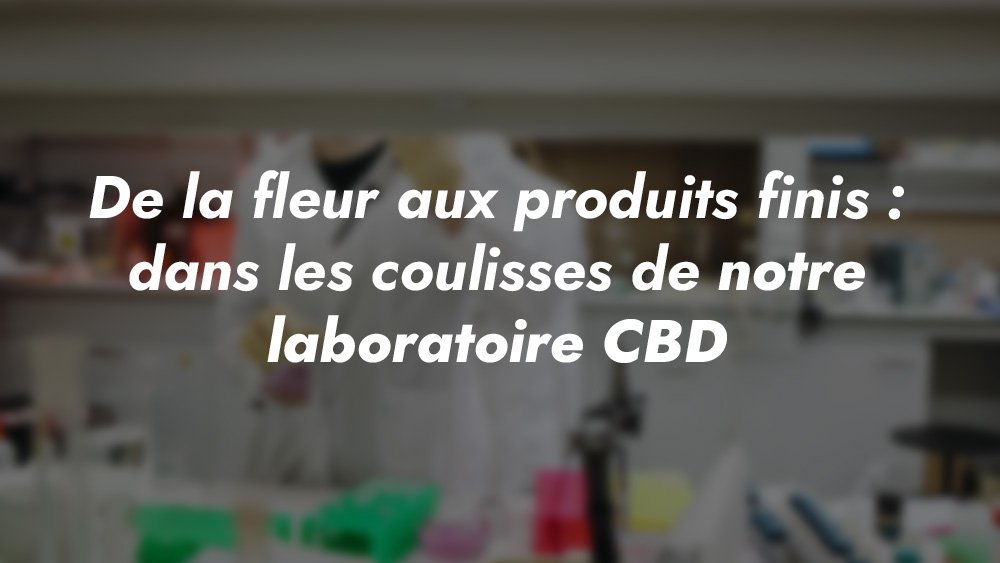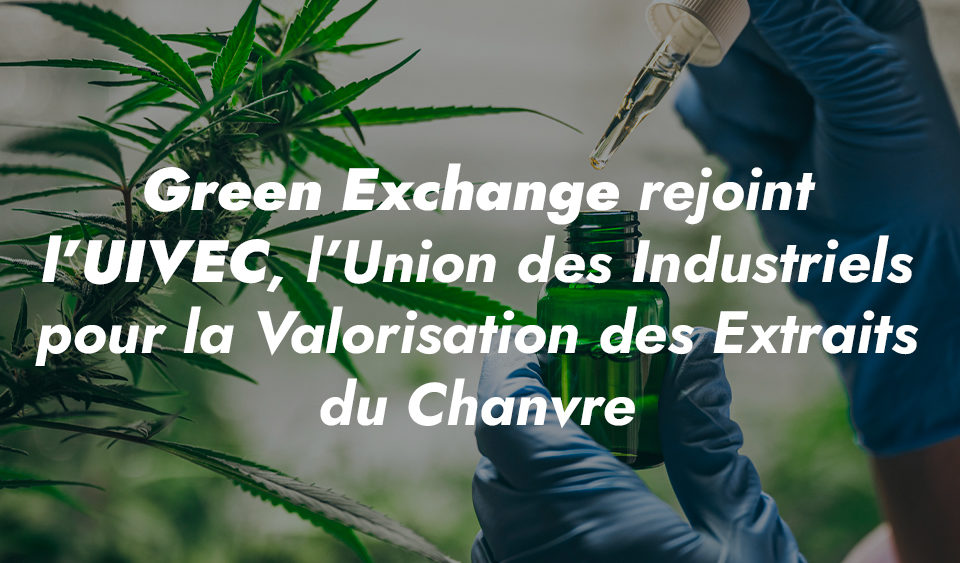
CBD manufacturer: 5 reasons to trust Green Exchange
April 11, 2023
Our tips for storing CBD products
August 5, 2023How are hemp products made? If you're interested in finding out, you've come to the right place! Today, the Green Exchange Lab team opens the doors of its CBD laboratory laboratory and reveals the main stages in the manufacture of its products.
Green Exchange Lab: Brief presentation of our French CBD laboratory 
We set up our CBD laboratory in 2016, long before hemp-based products flooded the French market! In fact, at the time,cannabinoid extraction was still prohibited in France.
That's part of the reason why our CBD laboratory was initially based in Switzerland. Then, when the opportunity arose, we moved to France. And we took the opportunity to increase our extraction capacity and develop our know-how as a fabricant of CBD-based products.
In fact, our investments, combined with our experience, have enabled us to position ourselves today as one of the most modern and sophisticated CBD laboratories in the sector.
We currently process around 100 kg of biomass per day. Biomass from our Agrican farm in northern France, as well as from partner farms, most of which are also French.
The steps involved in manufacturing a CBD product
The principle behind the manufacture of a hemp-based product is, in itself, quite simple: first, the active ingredients are active ingredients (cannabinoids and terpenes) (cannabinoids and terpenes), then we purify the resulting extract before refinedaccording to the desired degree of purity and composition.
Here are a few more details...
Extraction: the famous crude oil is obtained
The extraction stage involves physically separate the trichomes from the rest of the flower. The trichomes are the glands that synthesize the phytocannabinoids and terpenes terpenes. Visually crystalline, these little hairy drops actually contain the precious cannabis resin.
On an artisanal scale, the extraction of cannabis resin, known as "crude oil crude oil, is fairly straightforward. Indeed, both cannabinoids and terpenes are fat-solubleThis means that all that's needed to separate them from the plant is a fatty substance. A simple sieve can also suffice, which is how hashish is traditionally made.
However, on an industrial scale, using vegetable oil to extract CBD and other plant components is not an economically viable solution, especially as the quality of the resin obtained is not optimal.
This is why cannabis professionals use extraction methods borrowed from the food and pharmaceutical industries. We detail the different extraction techniques we use in our CBD laboratory later in this article. later in this article.
Purification: winterization and filtration
Crude oil is, so to speak, an extract of raw cannabis. It contains fats, chlorophyll and possibly residues of the solvent used during extraction.
To obtain pure crude oil, two purification steps are required:
- Winterizationwhich consists of cooling crude oil (mixed with ethanol) in order to crystallize impurities and vegetable fat;
- And filtrationwhich is no more and no less than mechanical filtration.
These two stages are particularly delicate, because for the process to be effective, the crude oil must be kept between -80°C and -20°C for 24 hours. Then a race against time begins, as the miscella obtained during winterization before it warms up. This would dissolve the crystallized impurities, rendering the whole process obsolete.
These two steps can be repeated several times, until a pure crude oil is obtained, with no residual vegetable fats and no solvents.
Decarboxylation: from CBDa to CBD
At this stage, crude oil is rich in cannabinoids and terpenes... But there's still one important detail to take care of before it can be processed into a finished product.
Indeed, the precious liquid does not yet contain CBD, THC, CBN, CBG, etc., but CBDa, THCa, CBNa and CBGa. CBDa, THCa, CBNa and CBGawhich are their acid forms.
At the molecular level, CBDa simply has one carbon group group than CBD. To remove it, the crude oil has to be heated to a certain temperature for a certain length of time. This too is a very delicate stage, as the acidic forms of the cannabinoids need to be heated sufficiently to transform them into their active forms, without allowing the terpenes to evaporate.
Remediation / Distillation / Crystallization
Our crude oil is now free of impurities and contains all the molecular baggage of hemp flowers. But there's more to come!
This is because its THC content is too high to be sold in this way (it exceeds the permitted 0.3%). An additional step is therefore needed to lower the THC concentration without altering that of the other cannabinoids. Furthermore, to manufacture a wide range of CBD products, we need to separate certain cannabinoids in their pure form.
Depending on the product we wish to manufacture, there are three possible processes for our crude oil:
- Remediation Remediation: we use a technique called "chromatography" which enables us to isolate any cannabinoid. Remediation enables us to obtain a full spectrum crude oil (with less than 0.2% or even 0% THC);
- Distillation Distillation: a process which enables us to obtain what is known as a broad spectrum CBD distillate. This is a liquid highly concentrated in CBD (between 80 and 90%) which also contains all the other cannabinoids except THC;
- Crystallization : With this process, we obtain CBD in its purest form (99.6%). These are CBD crystals.
These three types of intermediate products then enable us to produce a wide range of CBD products. We'll talk more about them later in this article.
Extraction methods used in our CBD laboratory
Before telling you about our products, we'd like to take a closer look at the first stage of production, when the trichomes are separated from the flowers.
In fact, our CBD laboratory coexists with three extraction techniqueseach with its own advantages and disadvantages, making Green Exchange a true specialist in the field.
Supercritical CO2 extraction
Every extraction requires a solvent. In this case, the solvent is carbon dioxide in its fluid state (supercritical state).
This extraction technique offers a number of advantages, particularly in terms of efficiency. It enables selective and precise extractionwhich means it is possible to target the molecules to be extracted. In addition, the quality of the crude oil obtained is excellent.
However, supercritical CO2 extraction has a number of substantial drawbacks. CO2 extraction machines are not easy to operate, and you need a good knowledge of chemistry to use them... Especially as the process is carried out at high pressure, which represents a certain danger.
But as far as we are concerned, the main challenge of using supercritical CO2 is that it it closes the door on organic labels. And yet, obtaining organic certification is one of our main objectives.
Extraction with supercritical CO2 is well publicized as a "natural" technique, because it doesn't use any residual solvents... It's true, we don't use any during the extraction process. However, next comes the purification stage, which is carried out with ethanol or bio-ethanol.
Cryogenic ethanol extraction
Strangely enough, ethanol extraction is poorly perceived by industry and consumers alike. Yet the vast majority of us consume it regularly! Let's not forget that ethanol is the oldest solvent in the world, used to capture the spiritual essence of plants.
Admittedly, the use of ethanol suggests a number of constraints to be taken into account: the process is not not specific like CO2 extraction, which means that the crude oil obtained is necessarily full spectrum. Furthermore, as everyone knows, alcohol is volatile and highly flammable.
However, we have at least two good reasons for using cryogenic ethanol extraction in our CBD lab.
The term "cryogenic ethanol extraction" is a misnomer. Scientifically speaking, ethanol is not cryogenic (between -153°C and -273°C), it is cooled (between -40°C and -30°C).
The first is that the process is efficient. In fact, ethanol is a universal solvent (polar and non-polar), which means that all cannabis molecules can be extracted. And the use of low-temperature ethanol effectively limits the extraction of chlorophyll and vegetable fat.
The second reason, and not the least important, is that ethanol (or bioethanol) is of natural origin It is obtained through the fermentation of plants. As a result, CBD products obtained through ethanol extraction can be certified organic.
Hydrocarbon extraction
Hydrocarbons are organic compounds made up exclusively of carbon and hydrogen atoms. Petroleum is undoubtedly the most popular of all hydrocarbons, including liquefied gases, propane and butaneare two of the most widely used organic solvents in the industry for extracting hemp compounds.
In fact, extraction with these organic solvents is relatively economicalin addition to being efficient yields are excellent (up to 30%, compared with 8% for supercritical CO2), cannabinoids and terpenes are extracted without being altered, chlorophyll and plant fat are not extracted, so there's no need for a purification stage, and the process itself is safe, since the machine operates at relatively low pressures.
Contrary to popular belief, the use of butane and propane is considered to be safe for health by regulatory bodies. That's why this type of extraction is so common in the food sector.
However, extracted from petroleum, propane and butane find themselves the antithesis of our ecological ideals.
That's why we want to use tetrafluoroethane (TFE, or R134a), the hydrocarbon that replaces CFCs (known for their damaging effects on the ozone layer) in aerosols. Considered safe for health (used in the medical and pharmaceutical industries), TFE enables all cannabinoids and terpenes to be extracted without damaging them, at low pressure and low temperature.
This is an innovative extraction technique innovative that our team of experts is in the process of taming exclusively.
CBD products manufactured in our laboratory
Now you know how to obtain crude oil, the basic ingredient in all CBD products. And let's talk about our CBD products!
Our CBD oils 🌱
The most popular hemp product of all is undoubtedly CBD oil. As you know, they fall into two broad categories:
- Full spectrum oil contains all the molecules synthesized in hemp flowers. It is obtained from hemp seed oil and remediated crude oil (to reduce THC levels to less than 0.3%);
- Broad spectrum oil This oil also contains all the hemp molecules except THC. To obtain it, we add CBD distillate to our hemp seed oil.
We also offer a third type of CBD oil:
- Innovative CBD oils These are formulas enriched with one or more target cannabinoids. For example, we offer a broad spectrum CBD oil enriched with CBN and/or CBG. To obtain this type of oil, we add CBD distillate and CBN and/or CBG isolate to our hemp seed oil.
Our cannabis extracts 🧪
This type of CBD product is characterized by a high concentration of cannabinoids and/or terpenes.
This is why, in most cases, we prefer to use butane or propane (and soon TFE) extraction to make our extracts. As we have already mentioned, this extraction technique produces a highly concentrated crude oil in cannabinoids and terpenes, while isolating the chlorophyll and plant fat.
To obtain the different CBD extracts, which essentially vary in consistency, various additional processing steps are required.
CBD extracts can be divided into 3 categories: raw extracts, refined extracts and processed extracts.
#1. Crude oil and mother liquor (crude extracts)
As we have already explained, just after the extraction stage, we obtain crude oil, which is a crude concentrate composed of CBD (around 60%), minor cannabinoids (around 5%, with or without THC) and terpenes.
In fact, at this stage, we also harvest what we call "mother liquor". "mother liquorwhich contains all the compounds not retained in the crude oil.. In other words: CBD (around 40%), but also minor cannabinoids (around 35%).
#2. Distillate and isolate (refined extracts)
Crude oil can be incorporated as is into the formulation of certain products (typically oils), but it can also undergo a few additional steps to obtain a purer, more concentrated extract : the distillate. Note that there are all kinds of distillates, from the traditional CBD full/broad spectrum distillate to H4CBD distillate, via CBN and CBG distillates.
It is possible to go even further, and to and refine the extract to its maximum by isolating a single cannabinoid, usually cannabidiol. This is known as CBD isolate. A kind of crystal powder, the isolate is concentrated to over 99%.. It therefore contains no terpenes, making it the ideal ingredient for cosmetics and food products. It can also be used to increase the CBD content of any product.
#3. Wax, shatter, crumble (processed extracts)
To obtainterps sauce, wax, crumble or shatter, we chill our crude oil until we reach the desired consistency, and remove any excess water in the case of shatter, whose texture is reminiscent of crystallized caramel.
Unlike previous extracts, these can be consumed as they are, usually with a water pipe.
Our CBD flowers 🍁
Of course, there's no shortage of CBD flowers in our catalog! As we mentioned earlier, they come from our Agrican farm in northern France.
The vast majority of our our greenhouse flowers (grown in 7500 m² of greenhouses) as well as our our outdoor flowers (grown on over 6000 m² of outdoor space). In both cases, we use no pesticides or chemical fertilizers, and do our utmost to limit our energy consumption.
Other flowers, including indoor CBD flowers (flowers come from a partner farm in Switzerland.
We try to include as many different a maximum of different varieties (to satisfy all our customers. These varieties are, of course, perfectly legali.e. registered in the European catalog. They are all CBD-dominant.
However, the THC concentration in trichomes is not always less than 0.3%. Our equipment enables us to lower this level without damaging the terpenes and other cannabinoids, guaranteeing 100% legal CBD flowers.
And to satisfy consumers eager for maximum CBD content, we also offer CBD rocks rocks: flowers soaked in a distillate bath, then coated with CBD crystals or pollen. Their CBD concentration can reach 80%.
Our CBD innovations 🆕
Our catalog is constantly evolving, because we are constantly seeking to innovate. We also have our eye on the USA, where cannabis products are much more developed than in the EU.
This is how you will find a few nuggets, rare or unpublished products, always of the highest quality:
- Water-soluble CBD Water-soluble CBD allows you to enjoy the benefits of CBD without the addition of fat;
- Moon Rock and CBN hash CBN: CBN is a minor cannabinoid in cannabis, present in small quantities in flowers (less than 1%). Our extraction techniques enable us to produce CBN-enriched products such as Moon Rock and hash;
- Infused e-liquid The terpenes are literally infused into the e-liquid, without any intermediate extraction process, thus preserving the authenticity of the flower's terpene profile. This is a Green Exchange invention.
- CBD cartridges cartridges: CBD/CBN wax packaged in syringes for easy consumption of this viscous CBD extract.
- ... and many more!
If you would like to work with us, please contact our team, who will be happy to answer any questions you may have.






